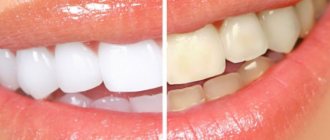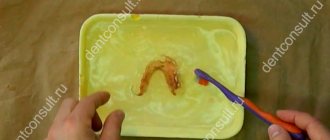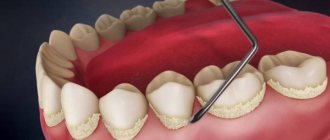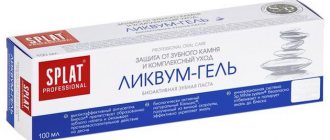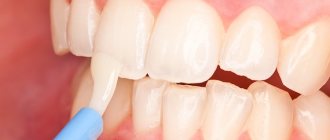What is tartar and what are the causes of its appearance?
Tartar is hardened plaque that forms on the visible part of the tooth (crown) and under the gum.
The reasons for its appearance are natural, but the consequences can cause pathologies in the oral cavity.
Initially, food particles stick to the enamel. Bacteria begin to actively multiply in them. A dental plaque is formed, which looks like a soft, light plaque. Plaque can be easily removed by regular tooth brushing. But if this does not happen, then food debris, dead cells of the mucous membrane, calcium and phosphorus salts from saliva are layered on the soft plaque. They crystallize and harden.
Mineralization occurs on average within 12 days. Soft plaque turns into hard plaque. Tartar has a rough surface, onto which more and more elements “cling.”
Attention: A bacterial film on teeth forms within 16 hours. Therefore, it is important to brush your teeth at least twice a day.
Photo of plaque, male jaw
Why hard deposits form
Plaque formation is inevitable, but there are a number of factors that accelerate the process:
- Irregular hygiene. Particularly active formation of plaque and stone occurs at night: salivation decreases, a person swallows less often, and does not move the tongue. This creates a favorable environment for bacterial growth.
- Poor hygiene. Brushing teeth with horizontal movements does not affect hard-to-reach areas. The interdental spaces should be cleaned by moving the brush vertically.
- Diet. A large amount of sweet and starchy foods leads to the sticking of carbohydrates to the enamel and the proliferation of pathogenic microflora. To reduce the rate of plaque formation, you should eat fresh, firm vegetables and fruits. Chewing the fibrous pulp for a long time partially helps remove plaque.
- Physiological features. Incorrect bite and crowded teeth make proper cleaning difficult.
- Metabolic disorders. The composition of saliva changes, its bactericidal properties decrease.
- Smoking. Cigarette tar settles on the teeth, causing the formation of films and plaques.
Features of sinus lifting
- There are two methods of performing surgical intervention. The closed or gentle option is performed simultaneously with implantation. It is carried out as follows: in the bed formed for the artificial root, a hole is drilled to the maxillary sinus, then the bottom is raised with special tools or balloons, after which the cavity is filled with osteoplastic material and the implant is fixed. Open sinus lifting or lateral surgery is performed for significant bone tissue deficits and does not imply immediate installation of an implant. Here, access to the bottom of the sinus is made through the anterior surface of the gum.
- Sinus lifting involves the use of osteoplastic material. They come in several types: autogenous (taken from the patient himself), allogeneic (taken from another person), xenogeneic (animal transplants) and artificial materials. The choice of one option or another is made individually and depends, to a greater extent, on the financial situation of the patient, as well as on health indicators and probable risks.
- Preparation for surgery includes a number of laboratory and instrumental (x-ray) studies. The doctor must have a clear understanding of the patient’s health, the structure of his jaw apparatus and other features of a particular clinical case.
- Sinus lifting is performed under local anesthesia, but in rare cases patients require general anesthesia.
- Rehabilitation involves following a number of recommendations. On average, engraftment of the material occurs within 4-6 months, after which treatment is completed.
Each stage of bone grafting is extremely important, and following clear rules will help avoid complications. In addition, the patient should pay attention to the reputation of the clinic when contacting and the experience of the attending physician. Bone grafting is a modern operation that is constantly being improved. If the dentist constantly performs it and improves his own skills, then the patient can be confident in a favorable outcome of the treatment.
Why is ultrasonic cleaning necessary?
Professional teeth cleaning in a clinic identifies problem areas and helps avoid future diseases.
- Detects caries. The destruction of enamel and dentin can be hidden under a layer of tartar. If caries is discovered later, it should be cured.
- Prevents the formation of new caries, including those who wear braces.
- Prevents gum inflammation, periodontitis, exposed roots, bleeding, and bad breath.
- Prepares the oral cavity for surgery and implant installation. Removing colonies of bacteria living in dental plaque ensures the safety of manipulations that violate the integrity of tissues.
- Brightens teeth without aggressive chemical whitening.
Photos BEFORE and AFTER cleaning
Ultrasonic teeth cleaning in a dental clinic in Moscow – “Aesthetica”
We offer our patients a comprehensive oral hygiene service, which includes ultrasonic teeth cleaning and Air Flow removal of pigmented plaque. We carry out procedures using modern and highly efficient equipment, under magnification, which gives us the opportunity to achieve impeccable quality of teeth cleaning.
Our specialists pay close attention to grinding and polishing the teeth after the cleaning procedure. If you do not grind and polish your teeth after removing plaque, it will accumulate quickly and actively. After completing the comprehensive cleaning procedure, our hygienists will definitely introduce you to all the rules of caring for your teeth and oral cavity, and will help you choose the right tools for home hygiene.
You can sign up for a consultation with our specialists at any branch of the Aesthetica clinic in Moscow - in Barvikha or Podsosensky Lane!
Is ultrasonic teeth cleaning harmful?
Ultrasonic cleaning does not pose any threat to teeth and the body as a whole. An exception is situations in which the technology is broken or the patient has contraindications. Ultrasound can damage enamel if it is thinned or has such a structural feature. Sometimes brushing causes bleeding from the gums. The doctor will help stop it and advise what needs to be done for speedy healing.
Advice: to avoid possible troubles, before starting the procedure, the dentist finds out the state of health, concomitant diseases, and reaction to medications. Answer honestly and directly, every nuance matters.
Caring for your teeth after ultrasonic cleaning
After the procedure, especially if a lot of plaque has been removed, there is a slightly increased sensitivity of the teeth to temperature and chemical irritants, so for 24 hours after cleaning, patients are advised to refrain from eating excessively hot, cold, sour and salty foods. It is advisable to follow a “white diet” for a couple of days, as after teeth whitening, to exclude strongly coloring foods from the diet (red wine, coffee, black tea, beets, some bright fruits and juices from them) so that the cleaned enamel does not absorb food dyes, and on the contrary, enrich it with solid and fiber-containing products that will prevent the appearance of plaque and stones (fruits, vegetables, nuts, etc.).
If sensitivity is severe, it is recommended to replace your regular toothbrush with a soft-bristled brush for several days and purchase toothpaste that reduces sensitivity.
After each meal, you need to rinse your mouth with clean water - this rule must be observed not only after ultrasonic cleaning, but also constantly.
On the first day or two, it is also recommended to brush your teeth after every meal.
Pros and cons of ultrasonic tartar removal
Unlike other methods, ultrasonic cleaning has a number of advantages:
- Removes subgingival calculus that is difficult to reach with traditional instruments. To clean the root zone, the doctor pulls back the gums and works with the neck and root of the tooth.
- Cleans the interdental spaces even of very dense teeth, uneven, overlapping one another.
- The procedure does not last long - 40-60 minutes.
- Painless. The patient does not feel any impact.
- Non-contact influence. Only air and water come into contact with teeth. With the outdated mechanical method, the instruments scratch the enamel and cause an unpleasant “grinding” sensation.
The most frequently asked questions from patients about the procedure
How painful is it?
(click to expand) Ultrasound teeth cleaning is a painless procedure, but it may be accompanied by minor discomfort in the presence of subgingival dental deposits - to remove them you need to slightly disturb the gums. Patients with increased sensitivity of the enamel may also complain of pain. In such cases, the doctor will perform cleaning with maximum comfort for the patient, using local anesthesia.
Is ultrasonic cleaning whitening? (click to expand) No, whitening is a completely different procedure, it is carried out using special whitening compounds that are applied to the tooth. A slight lightening of the enamel is due to the fact that after ultrasonic cleaning, the surface of the teeth is polished; sometimes the difference in color is clearly visible.
Is it true that plaque appears on teeth faster after ultrasonic cleaning? (click to expand) No, that's not true. On the contrary, after ultrasonic cleaning followed by polishing the enamel, plaque appears more slowly. Maintaining oral hygiene helps prevent its occurrence: responsible brushing of teeth at least 2 times a day, rinsing the mouth after meals, choosing the right toothpaste. Smoking, excessive consumption of tea and coffee, and metabolic disorders in the body contribute to the rapid appearance of plaque.
Can cleaning damage the enamel? (click to expand) If the procedure is carried out correctly, damage to tooth enamel is excluded. After cleaning, weak and thin enamel is additionally strengthened with remineralizing gels, the enamel is actively saturated with microelements, and it becomes stronger.
What should I do if I have an acute inflammatory process on my gums? (click to expand) Acute inflammation of the gums, accompanied by bleeding, in most cases is a contraindication to ultrasonic teeth cleaning until acute symptoms are relieved. We offer our patients tartar removal simultaneously with gum treatment using the Vector device. This is a specially designed ultrasonic scaler that is equipped with a unique Paro tip that creates special ultrasonic vibrations. The device allows for deeper treatment of periodontal pockets if the patient is diagnosed with periodontitis; Simultaneously with the removal of dental plaque, the enamel is polished with a special polishing liquid. After its use, supragingival and subgingival deposits, inflammation of soft tissues and bleeding are completely eliminated, bad breath disappears, and oral health is restored.
Is the procedure allowed during pregnancy? (click to expand) Ultrasonic teeth cleaning is not only allowed for pregnant women, but is also recommended for mandatory use. This is explained by the frequent occurrence of problems with teeth and gums in pregnant women due to hormonal changes and the need to sanitize the oral cavity before childbirth. The procedure is completely safe for the health of the expectant mother and her baby, but you still need to consult a gynecologist before performing it.
How often should you resort to ultrasonic teeth cleaning? (click to expand) We recommend that our patients have their teeth cleaned with ultrasound every 6-12 months; sometimes, if there is an increased tendency to form plaque, cleaning is done more often. The best solution is to carry out a comprehensive oral hygiene cleaning, which helps maintain oral health and fresh breath.
Ultrasonic teeth cleaning helps prevent the development of many dental diseases, so do not neglect this procedure.
Main stages of ultrasonic processing
The dentist conducts an examination, identifies places where tartar accumulates, the amount, and determines its density in order to choose the appropriate cleaning regimen. Sometimes teeth are treated with a special solution that reveals the boundaries of plaque. If the patient has sensitive teeth, gums or deep subgingival calculus, anesthesia (injection or application) is performed.
Stone removal is carried out in three stages:
Brushing teeth with a skyler
Skyler is a dental instrument that generates ultrasonic air vibrations. Water (an antiseptic solution) mixed with air is sprayed through a narrow nozzle. The liquid is intended to cool the tooth and wash away the separated plaque.
The ultrasonic wave forms cavities in mineralized deposits, the plaque cracks and peels off from the enamel. The fragments are removed with a saliva ejector.
First, the doctor cleans the crowns, then the subgingival area, guiding the scaler with parallel vertical movements.
Brushing teeth with a skyler
Polishing
Cleaned teeth have a rough surface. To slow down the adhesion of food and bacteria, polishing is used.
Main types:
- Mechanical with special paste and a round elastic brush. The interdental spaces are polished with thin strips or narrow spiral-shaped brushes.
- Hardware using the AirFlow method - using a powerful jet of water with an abrasive containing sodium bicarbonate.
Brushing your teeth with a special paste and a round brush
Fluoridation
Fluoridation helps strengthen enamel and reduce hyperesthesia (sensitivity) in the cervical area.
- The tooth surface is dried with a stream of warm air for better adhesion.
- Apply a composition containing fluoride ions (gel or varnish) and dry again.
- The teeth are treated with a swab soaked in copper hydroxide and calcium solution. The substances enter into a chemical reaction, and calcium fluoride crystals are formed in the dentinal tubules and other irregularities, which strengthen the tooth tissue and prevent infection.
How is the ultrasonic teeth cleaning procedure performed in the dentist’s office?
Before the ultrasonic cleaning procedure, the patient’s oral cavity must be examined. During this examination, the doctor determines the quality of hygiene, as well as the amount of dental plaque that needs to be removed. If the patient is concerned about possible pain during ultrasonic teeth cleaning, then local anesthesia is given before the procedure.
After the anesthesia takes effect, an ultrasonic cleaning procedure is carried out, which includes the following sequential steps:
- Ultrasonic cleaning of tooth surfaces during which soft plaque is removed;
- Removal of hard deposits along the gum line;
- Ultrasound cleaning of periodontal pockets.
To remove plaque that has penetrated deep into the enamel pores, Air Flow cleaning technology is additionally used.
The ultrasonic teeth cleaning procedure is completed by grinding and polishing the enamel. To carry out these procedures, special pastes with abrasives and grinding attachments are used. Finally, the tooth enamel is coated with fluoride-containing preparations that strengthen and restore its integrity.
NOTE: Fluoridation or remineralization of enamel is not a mandatory procedure after ultrasonic cleaning. But we advise you not to refuse to carry them out, since fluoridation and remineralization strengthen the enamel, remove hypersensitivity, and act as an excellent prevention of caries.
Contraindications
The most important contraindication is the presence of a pacemaker in the patient. Ultrasonic waves can disrupt its operation.
Other restrictions also apply to health conditions:
- asthma, bronchospasm, tuberculosis,
- increased risk of bleeding,
- allergies to the drugs used,
- infectious and viral diseases,
- oncology,
- mental illness, epilepsy.
Attention: Relative contraindications are pregnancy (first trimester), childhood (up to 16-18 years). The decision to perform the procedure is made by the dentist.
When it might be painful or unpleasant
Ultrasonic cleaning is a modern, effective method with minimal trauma. Most patients tolerate the process without discomfort.
Pain when cleaning with ultrasound
Pain can occur due to individual characteristics or due to erroneous actions of the doctor.
Features include thin, sensitive enamel - a semblance of shocks and pressure is felt. Weakened gums that are prone to bleeding are easily subject to microdamage and painful sensations appear. If there is extensive subgingival calculus, the doctor works in this area for a long time, which can also lead to discomfort.
Is there any discomfort during laser cleaning?
This method does not cause pain. The laser beam destroys pigments and evaporates water in hard and soft deposits. Their remains are washed off from the surface with water. In this case, there is no effect on the enamel. Gum pockets are not treated with laser; therefore, there is no contact with soft tissues.
Features of chemical tartar removal
The method is rarely used, because has few advantages, including speed and affordable price. Chemical removal has more disadvantages: thinning of the enamel, possible burns of the mucous membrane if performed incorrectly, poor cleaning of the interdental space, allergies to the products used, oxidation of orthodontic metal structures.
Sequencing:
- installation of protective plates on the gums,
- applying acidic and alkaline compounds for 2-3 minutes,
- rinsing, polishing, fluoridation.
Chemical removal of tartar
How painful is it to remove stone manually?
This contact method can only be painful if the doctor's hand accidentally slips and the instrument scratches the gum. Also, the disadvantages include incomplete removal of plaque and stone in hard-to-reach places. Mechanical cleaning is contraindicated for thin, sensitive enamel, inflammation of the gums, and infectious lesions of the mucous membrane.
Nowadays, dentists recommend removing tartar manually less and less often.
Complications after surgery
Sinus lifting, like other dental surgeries, can be accompanied by a number of complications. The main danger of any adverse outcomes lies in problems with the osteoplastic material and an increase in the duration of treatment. In rare cases, the result of the operation is canceled, and the possibility of repeat bone grafting disappears.
There are the following complications of bone grafting and sinus lifting:
- Bleeding. It occurs in the first hours (sometimes within 24 hours) and indicates the presence of problems with blood clotting. As a rule, a complication appears in the dentist’s office, so it is treated professionally and as quickly as possible. But if the problem has already started at home, then there is no need to try to solve it yourself, because bleeding from the arteries quickly leads to significant blood loss and disruption of life.
- Perforation of the sinus mucosa. Perforation of the protective membrane of the maxillary sinus is a complication specific to sinus lifting, from which no one is immune. The outcome of perforation depends on its size. In some situations, it is necessary to stop the process of bone grafting and completely focus on restoring the integrity of the cavity of the maxillary sinus.
- Infection. This problem occurs on days 2-3 of the rehabilitation period or later. The risk exists until the wound surface heals. The clinical picture of the infectious process includes an increase in temperature, progression of pain and swelling, and the appearance of purulent discharge. If the maxillary sinus becomes infected, then pain in the frontal region of the head is added.
- Displacement of osteoplastic material. Such a complication may be a consequence of the above-mentioned adverse outcomes or occur independently if general recommendations are not followed during the rehabilitation period. In the first weeks after a sinus lift, the patient should not overexert himself physically, fly on airplanes, dive, sneeze and cough with his mouth closed, blow his nose, or drink drinks through a straw.
- Loosening and retraction of the implant (if it was installed). This complication is typical only for those types of bone grafting where one-stage fixation of an artificial root is possible, for example, with a closed sinus lift. Poor implant fixation is rarely the cause of an unfavorable outcome. In most cases, the cause is incorrect placement or filling with osteoplastic material, its displacement or excessive load on the implant during the rehabilitation period.
Complications of bone grafting occur very rarely, since modern technologies can minimize the risk of an unfavorable outcome. Patients are fully examined before surgery, and the dentist carefully plans every step. The occurrence of one or another complication indicates a violation of the technique of performing the operation, the patient’s refusal to follow the doctor’s recommendations, and in rare cases, unforeseen accidents.

